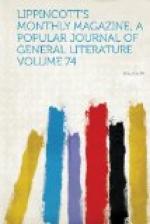Rich relations, as a general thing, are abominable: the mere possession of one sometimes makes a person disagreeable. Show the person with a rich cousin the most secluded cot among mountains, and, “Oh, you should see my cousin’s house on Michigan Avenue!” is the reply; or a beautiful room speaking the noble quality of its occupant, and, “Call that nice? You should see my cousin’s house on Michigan Avenue!” is remarked. But Lydia’s rich relations, the Stenes of Chicago, appeared to be exceptions. They were very clannish people, fond of their own kin to the last degree. They came from Michigan, and were of the old colony stock, regular Yankee-Doodle folks, the older ones and many of the younger ones still using New England idioms and quaint phrases that came long ago from the East—yes, from the holts of old England’s Suffolk perhaps. You could not persuade one of them to call jelly anything but “jell” or a repast anything but a “meal of victuals,” and they said “dooty” and “roomor” and “noos” and “clawg,” and sometimes would pop out “his’n” and “her’n.” Several of the Stenes had been in business thirty years in metropolitan Chicago, yet they spoke in the twang of a Yankee hill-country. The women of the family were famous housekeepers—too neat to keep a cat lest there might be a cat hair on the carpet, and never liking visitors unless there was a dreadful note of preparation, and then they received grandly. To show Lydia their good-will, they gave her profuse wedding-presents and a splendid trousseau. On my side I bought a neat cottage, paying cash down—all the money I had. It was one of a square of cottages principally occupied by young married people having plenty of children, and a joyous crew they were. Our street had a broad roadway and flagged sidewalks edged with neat turf in which fine trees were growing, and was lined with beautiful homes of varied architecture, suggesting charming interiors. A row of tall, “high-stoop” New York houses with dark stone trimmings stood next to a row of English basements of tuck-pointed brick, and next to them was a range of houses of light, cheerful Joliet stone, with awnings at the windows and carriage-steps as clean as gravestones. Then came an old cottage fixed up nobby, then a comfortable old wooden mansion, then a splendid dwelling in the style of the fifteenth century, and after that the palace of a railway grandee. Here and there on a corner stood a Gothic church. All day well-dressed people trod our pavements and beautiful carriages rolled by our windows. Our cottage was my ideal of perfection: it had few rooms, but those spacious. We had no sitting-room. Let me see: what does that word suggest to my mind? A table heaped with stale newspapers, a stand piled with sewing, a darned carpet, scratched furniture and fly-specked wall-paper.




